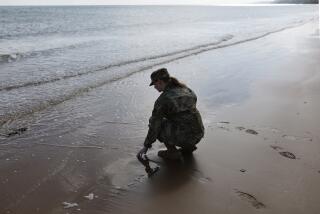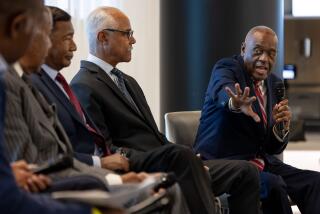Seabee’s Special Reenlistment Rite Salutes the Past
- Share via
PORT HUENEME — As a Seabee heavy equipment operator at Port Hueneme Navy Base, Alesia Stokes is known by fellow sailors for her ferocious work ethic and steely perseverance.
But at her reenlistment ceremony Friday morning, the 31-year-old former hairdresser was on the verge of tears.
At an emotional gathering meant to pay tribute to the history of blacks in the U.S. military, Stokes was sworn in by retired Buffalo Soldier Harry Hollowell.
Stokes picked the 82-year-old family friend to read her reenlistment pledge because Hollowell was a member of the Army’s all-black cavalry during World War II.
Navy reenlistment is often just a matter of protocol, with sailors hastily scribbling on the dotted line to commit to another multiyear stint. Stokes, however, wanted hers to have special meaning.
“This was an opportunity to let African Americans know, history is all around,” she said. “Let’s know the people who paved the way for us.”
Hollowell said he takes great pride in having been a Buffalo Soldier. To Friday’s ceremony, he wore a denim shirt, yellow neckerchief and cowboy-style hat, emulating the black soldiers’ uniforms. He boomed out Stokes’ reenlistment pledge with a puffed-out chest.
“They made their contributions as Americans, not as black men,” Hollowell said of the cavalry units, which were desegregated after World War II.
The black regiments were originally formed in the aftermath of the Civil War, and included the Army’s 9th and 10th Cavalry regiments and 24th and 25th Infantry divisions. The troops made their name on the frontier, battling with Native Americans as mostly European settlers pushed westward. The troops also chased cattle thieves and outlaws, and built roads and telegraph lines.
Historians say the term “buffalo soldiers” came from a term Native Americans used in referring to their opponents’ dark skin and hair texture. In recent years, the Buffalo Soldiers have captured the interest of historians, who are rewriting U.S. history books to include their contributions.
Their legacy remains strong in the black community. Oxnard Police Chief Harold Hurtt, for example, keeps a Buffalo Soldier statuette in his office.
Seabee Museum Director John Langellier has produced two television programs on the Buffalo Soldiers.
“Within the black community, hey represent a great sense of pride,” he said. “They’ve come to symbolize people willing to do their duty, while not willing to be second-class citizens.”
Chief Warrant Officer Hollowell was a member of the 10th cavalry at Ft. Leavenworth, Kan., from 1936 to 1942.
Those were waning days for the Buffalo Soldiers.
Desegregation of the military was nearing, while more durable tanks and trucks wiped out the need for horse-mounted troops in battle.
After his regiment disbanded and desegregation was implemented, the musically inclined Hollowell stayed in the Army and served as a band leader until 1964.
He credits the Army for giving him the chance to earn a steady paycheck in an era when employment opportunities for blacks were limited.
“There was the disadvantage of segregation,” he said, “but you worked around it.”
Stokes grew up in Leavenworth where Hollowell settled down after retiring.
The two families got to know each other when Hollowell brought his car to be fixed at an auto shop owned by Stokes’ father.
Three years ago, Stokes, who ran her own beauty salon in Leavenworth, decided to join the Navy.
“I got tired of hair,” she explains. “I was bored.”
Her friends started a pool in Leavenworth when Stokes enlisted--collecting bets on when she would drop out, Stokes said.
But with a resolve like that of a Buffalo Soldier, Stokes has impressed her Navy peers.
During her first tour of duty, Stokes helped set up encampments in Guantanamo Bay for Cuban refugees two years ago.
Recently, she became a Seabee combat warfare specialist, a designation earned through advanced-weapons training.
Stokes said that when she drives a bulldozer or tractor trailer, she feels a strong sense of control.
Her reenlistment is for six years, longer than the typical three- to four-year extension.
“I’ve never felt inferior to men,” she said. “I get in there, and I work beside them, not behind them. A lot of the time, I try to jump ahead of them.”
Seabee Brad Page, who earned his warfare pin at the same time as Stokes, said keeping up with Stokes can be tough.
“She operates that equipment better than a lot of us,” said Page, one of about 30 soldiers and family members who gathered at the base’s Heritage Park. “She’s putting some guys to shame.”
Beaming at the ceremony was J.C. Stokes, Alesia Stokes’ father, who spent 13 years in the Air Force, including a tour in Vietnam.
He noted that between Hollowell, himself and his daughter, they span three generations in the U.S. military.
“She’s been down other roads,” said the father. “But I knew she’d be successful here. She’s making her dreams come true.”
More to Read
Sign up for Essential California
The most important California stories and recommendations in your inbox every morning.
You may occasionally receive promotional content from the Los Angeles Times.













